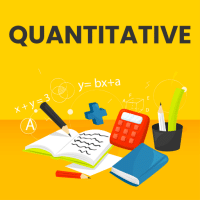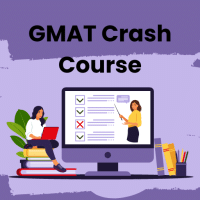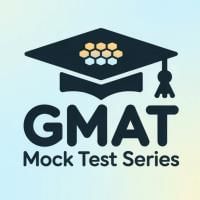GMAT Exam > GMAT Questions > Peter read P books last year, and Nikki read ...
Start Learning for Free
Peter read P books last year, and Nikki read N books last year. If Peter read 35 more books than Nikki last year, which of the following reflects the relationship?
- a)P > 35N
- b)< N - 35
- c)P > N + 35
- d)P = N - 35
- e)P = N + 35
Correct answer is option 'E'. Can you explain this answer?
Verified Answer
Peter read P books last year, and Nikki read N books last year. If Pet...
Step 1: Analyze the Question
The sentences in this word problem need to be translated into algebraic statements so that we can determine the relationship between the number of books that Peter and Nikki have read.
The sentences in this word problem need to be translated into algebraic statements so that we can determine the relationship between the number of books that Peter and Nikki have read.
Step 2: State the Task
Once the word problem has been translated, we will apply basic algebra to simplify the statement to match the correct answer choice.
Once the word problem has been translated, we will apply basic algebra to simplify the statement to match the correct answer choice.
Step 3: Approach Strategically
Translating the phrase "Peter read 35 more books than Nikki," we have P = N + 35.
Translating the phrase "Peter read 35 more books than Nikki," we have P = N + 35.
Step 4: Confirm Your Answer
This translation directly matches (E), but be careful to check that the variables are in the correct order.
This translation directly matches (E), but be careful to check that the variables are in the correct order.

|
Explore Courses for GMAT exam
|

|
Question Description
Peter read P books last year, and Nikki read N books last year. If Peter read 35 more books than Nikki last year, which of the following reflects the relationship?a)P > 35Nb)< N - 35c)P > N + 35d)P = N - 35e)P = N + 35Correct answer is option 'E'. Can you explain this answer? for GMAT 2025 is part of GMAT preparation. The Question and answers have been prepared according to the GMAT exam syllabus. Information about Peter read P books last year, and Nikki read N books last year. If Peter read 35 more books than Nikki last year, which of the following reflects the relationship?a)P > 35Nb)< N - 35c)P > N + 35d)P = N - 35e)P = N + 35Correct answer is option 'E'. Can you explain this answer? covers all topics & solutions for GMAT 2025 Exam. Find important definitions, questions, meanings, examples, exercises and tests below for Peter read P books last year, and Nikki read N books last year. If Peter read 35 more books than Nikki last year, which of the following reflects the relationship?a)P > 35Nb)< N - 35c)P > N + 35d)P = N - 35e)P = N + 35Correct answer is option 'E'. Can you explain this answer?.
Peter read P books last year, and Nikki read N books last year. If Peter read 35 more books than Nikki last year, which of the following reflects the relationship?a)P > 35Nb)< N - 35c)P > N + 35d)P = N - 35e)P = N + 35Correct answer is option 'E'. Can you explain this answer? for GMAT 2025 is part of GMAT preparation. The Question and answers have been prepared according to the GMAT exam syllabus. Information about Peter read P books last year, and Nikki read N books last year. If Peter read 35 more books than Nikki last year, which of the following reflects the relationship?a)P > 35Nb)< N - 35c)P > N + 35d)P = N - 35e)P = N + 35Correct answer is option 'E'. Can you explain this answer? covers all topics & solutions for GMAT 2025 Exam. Find important definitions, questions, meanings, examples, exercises and tests below for Peter read P books last year, and Nikki read N books last year. If Peter read 35 more books than Nikki last year, which of the following reflects the relationship?a)P > 35Nb)< N - 35c)P > N + 35d)P = N - 35e)P = N + 35Correct answer is option 'E'. Can you explain this answer?.
Solutions for Peter read P books last year, and Nikki read N books last year. If Peter read 35 more books than Nikki last year, which of the following reflects the relationship?a)P > 35Nb)< N - 35c)P > N + 35d)P = N - 35e)P = N + 35Correct answer is option 'E'. Can you explain this answer? in English & in Hindi are available as part of our courses for GMAT.
Download more important topics, notes, lectures and mock test series for GMAT Exam by signing up for free.
Here you can find the meaning of Peter read P books last year, and Nikki read N books last year. If Peter read 35 more books than Nikki last year, which of the following reflects the relationship?a)P > 35Nb)< N - 35c)P > N + 35d)P = N - 35e)P = N + 35Correct answer is option 'E'. Can you explain this answer? defined & explained in the simplest way possible. Besides giving the explanation of
Peter read P books last year, and Nikki read N books last year. If Peter read 35 more books than Nikki last year, which of the following reflects the relationship?a)P > 35Nb)< N - 35c)P > N + 35d)P = N - 35e)P = N + 35Correct answer is option 'E'. Can you explain this answer?, a detailed solution for Peter read P books last year, and Nikki read N books last year. If Peter read 35 more books than Nikki last year, which of the following reflects the relationship?a)P > 35Nb)< N - 35c)P > N + 35d)P = N - 35e)P = N + 35Correct answer is option 'E'. Can you explain this answer? has been provided alongside types of Peter read P books last year, and Nikki read N books last year. If Peter read 35 more books than Nikki last year, which of the following reflects the relationship?a)P > 35Nb)< N - 35c)P > N + 35d)P = N - 35e)P = N + 35Correct answer is option 'E'. Can you explain this answer? theory, EduRev gives you an
ample number of questions to practice Peter read P books last year, and Nikki read N books last year. If Peter read 35 more books than Nikki last year, which of the following reflects the relationship?a)P > 35Nb)< N - 35c)P > N + 35d)P = N - 35e)P = N + 35Correct answer is option 'E'. Can you explain this answer? tests, examples and also practice GMAT tests.

|
Explore Courses for GMAT exam
|

|
Signup for Free!
Signup to see your scores go up within 7 days! Learn & Practice with 1000+ FREE Notes, Videos & Tests.


















